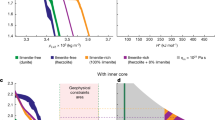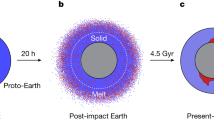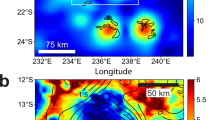Abstract
The discovery by Voyager 1 of several active volcanoes on Io1,2 opens up a new approach to problems such as the nature and consequences of volcanism on the celestial bodies. In the past 50 yr only Vsekhsviatsky has actively considered modern volcanism on planets, in particular on Moon-like bodies3,4. He proceeded from the concept of eruptive origin of comets, however, and did not suggest a physical mechanism to explain the volcanic activity he had postulated. The absence of modern volcanism on the Moon and Mars was against Vsekhsviatsky's ideas and few people considered them seriously, especially in connection with the possible volcanic ejection of icy blocks. Progress was made by Peale et al.5 who predicted the existence of the volcanoes just before they were discovered, and suggested a physical mechanism for the volcanism on Io. They suggested that the tidal dissipation caused by the orbit eccentricity could produce a power WMtid ≈ 1.6 × 1012 W in Io and 8 × 1010W in Europa. If the satellites are nonhomogeneous and have a molten interior, the energy release can increase several times. Peal et al. estimated the thickness of Io's solid crust as only 18km. However, “how can Io's south polar region support what appear to be toweling mountains? (ref. 6)”. (The typical relief is ∼10km here2). Also, the lack of a detectable intrinsic magnetic field of Io8 does not favour a fully molten interior. I have previously pointed out that Io's and Europe's orbiting in the strong magnetic field of Jupiter may cause their volcanic activity7 and this can be confirmed by simple calculations8,9. Here I shall estimate the energetics in more detail and discuss some peculiarities of the volcanism itself and consequences of the electromagnetic action mainly on the rocky satellites (the ‘icy’ volcanism will be considered elsewhere)
This is a preview of subscription content, access via your institution
Access options
Subscribe to this journal
Receive 51 print issues and online access
$199.00 per year
only $3.90 per issue
Buy this article
- Purchase on Springer Link
- Instant access to full article PDF
Prices may be subject to local taxes which are calculated during checkout
Similar content being viewed by others
References
Morabito, L. A., Synnott, S. P., Kupferman, P. N. & Collins, S. A. Science 204, 972 (1979).
Smith, B. A. et al. Science 204, 951–957, 960–972 (1979).
Vsekhsviatsky, S. K. Mém. Soc. R. Sci. Liège 12, 495–515 (1966).
Vsekhsviatsky, S. K. Astr. Vest. 12, 120–123 (1978).
Peale, S. J., Cassen, P. & Reynolds, R. T. Science 203, 892–894 (1979).
Science News 115, 164–165, 172–173 (1979).
Drobyshevski, E. M. Natn. Sem. on The Physics of Small Bodies of the Solar System, Dushanbe (1978).
Ness, N. F. et al. Science 204, 982–987 (1979).
Drobyshevski, E. M. Comet Circ. 246, 4 (24 March 1979).
Smith, R. A. in Jupiter (ed. Gehrels, T.) 1146–1189 (University of Arizona Press, 1976).
Piddington, J. H. & Drake, J. F. Nature 217, 935–937 (1968).
Goldreich, P. & Lynden-Bell, D. Astrophys. J. 156, 59–78 (1969).
Clotier, P. A., Daniell, R. E., Jr., Dessler, A. J. & Hill, T. W. Astrophys. Space Sci. 55, 93–112(1978).
Dessler, A. J. & Hill, T. W. Astrophys. J. 227, 664–675 (1979).
Piddington, J. H. The Moon 17, 373–382 (1977).
Dermott, S. F. Mon. Not. R. astr. Soc. 149, 35–44 (1970).
Schatten, K. H. & Ness, N. F. Astrophys. J. 165, 621–631 (1971).
Hanel, R., Science 204, 972–976 (1979).
Vanjan, L. L. & Egorov, I. V. The Moon 17, 3–9 (1977).
Pounder, E. R. The Physics of Ice (Pergamon, Oxford, 1965).
Franz, W. Dielektrischer Durchschlag, Handbuch der Physik, Vol. 17, 155 (Springer, Berlin, 1956).
Peale, S. J. & Cassen, P. Icarus 36, 245–269 (1978).
Science News 115, 231 (1979).
Head III, J. W. Revs. Geophys. Space Phys. 14, 265–300 (1976).
Markhinin, E. K. The Role of Volcanism in the Earth Crust Formation (in Russian) (Nauka, Moscow, 1967).
Broadfoot, A. L., et al. Science 204, 972–982 (1979).
Bodenheimer, P. Icarus 23, 319–325 (1974).
Drobyshevski, E. M. The Moon and the Planets 18, 145–194 (1978).
Cameron, A. G. W. & Pollack, J. B. in Jupiter (ed. Gehrels, T.) 61–84 (University of Arizona Press, Tucson, 1976).
Drobyshevski, E. M. Nature 250, 35–36 (1974).
Goldreich, P. & Peale, S. J. A. Rev. Astr. Astrophys. 6, 287–320 (1968).
Knopoff, L. Rev. Geophys. 2, 625–660 (1964).
Singer, S. F. Geophys. J. R. astr. Soc. 15, 205–226 (1968).
Burns, J. A. Nature phys. Sci. 242, 23–25 (1973).
Peale, S. J. Astr. J. 79, 722–744 (1974).
Author information
Authors and Affiliations
Rights and permissions
About this article
Cite this article
Drobyshevski, E. Magnetic field of Jupiter and the volcanism and rotation of the Galilean satellites. Nature 282, 811–813 (1979). https://doi.org/10.1038/282811a0
Received:
Accepted:
Issue Date:
DOI: https://doi.org/10.1038/282811a0
This article is cited by
-
The history of titan, of Saturn's rings and magnetic field, and the nature of short-period comets
The moon and the planets (1981)
-
The eruptive evolution of the Galilean satellites: Implications for the ancient magnetic field of Jupiter
The Moon and the Planets (1980)
Comments
By submitting a comment you agree to abide by our Terms and Community Guidelines. If you find something abusive or that does not comply with our terms or guidelines please flag it as inappropriate.



